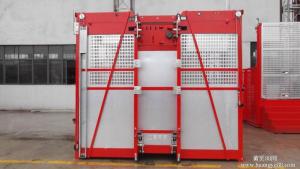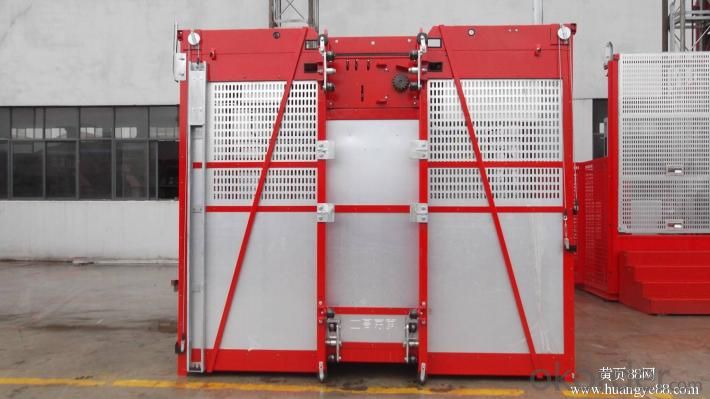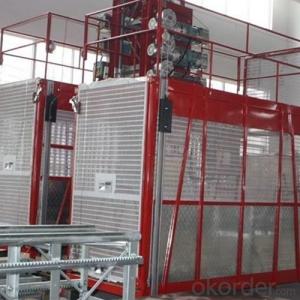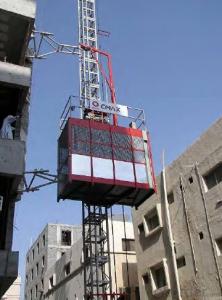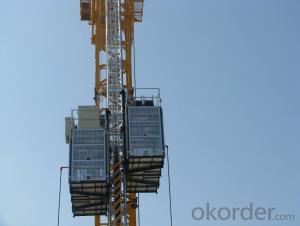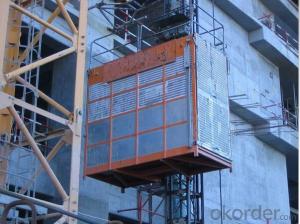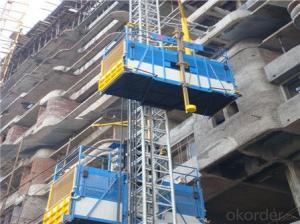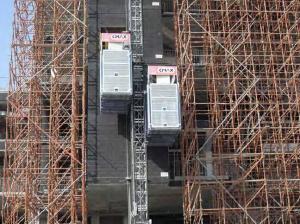Building Hoist (Model:SC(D)270, SC(D)270/270)
- Loading Port:
- China main port
- Payment Terms:
- TT or LC
- Min Order Qty:
- 1 unit
- Supply Capability:
- 20 unit/month
OKorder Service Pledge
OKorder Financial Service
You Might Also Like
Structure of Construction Hoist Description
(1)Creativeintroduce design philosophy single reducer dual output, the successful trial of a recyclable waste rack unit modular dual output construction lifts, lift the rack and pinion contact stress decreased by 50%, the transmission of the modular units can maximize the elimination of the error superimposed gear pair in the rack height direction, so that the whole movement is very smooth, greatly improving the rack and pinion and other key pieces of the life of this technological innovation for three national patents.
(2)A kind of automatic leveling floor, overload protection control and floor call, the three-in-one smart console application. Construction hoist intelligent automatic leveling floor, to ensure that the hoist can accurately place, to reduce machine wear and impact, and also slow down the drivers frequent operation of the degree of fatigue.
(3)Integrated operating room, frequency control system integration cabin. To strengthen safety and real using of hoist cage top job, at the same time greatly improve the aesthetic effect of the engine, the technology won the national patent.
(4)Advanced frequency control system. The construction elevator VVVF frequency control electrical control system adopts the most advanced frequency control and microcomputer programmable logic controller (PLC) control. Frequency control technology make the motor start, the braking process variable speed, ease the mechanical impact, and increased running stability, extended machine life. Brake can be achieved a zero speed, thereby extending the life of the brake. Frequency control system with a current limiting function, leaving the motor difficulty in starting the motor starting current, reducing the impact on the grid to ease the impact of the site electrical equipment, not because of the long distance power supply cable voltage drop. Frequency control system further comprising: overvoltage, undervoltage, overcorrect, overload, prevent stalling and other security features.
(5)Two Hardened reducerreached transmission efficiency up to 94%, big carrying capacity, long life. Efficient hardened gear together with the the advanced frequency electronic control system to lift the use of more energy-efficient. Construction ladder down the gravitational potential energy and kinetic energy is almost equivalent conversion, so that the motor operating current is almost zero, year-on-year ordinary domestic construction lift a nearly 50% reduction in energy-saving effect.
Construction Hoist Specifiction:
Name | Building Hoist |
Model | SC100, SC100/100 |
Certificate | ISO9001:2000 |
Capacity | 1000kg/cage |
Lifting speed | 36m/min,or 0~63m/min,or 0~96m/min |
Mast section: | Paint or hot dipping zinc |
Cage | Single cage or twin cage |
Cage size | (L x W x H) (m): 2.5 x 1.3 x 2.5; 3.0 x 1.3 x 2.5; 3.2 x 1.5 x 2.5; 3.6 x 1.5 x 2.5; 3.8 x 1.5 x 2.5; 4.0 x 1.5 x 2.5; 4.2 x 1.5 x 2.5, cage dimension is according to requirement of customer and special project |
Motor | Top brand of China,also can be SEW motor. |
Reducing device | Top brand of China |
Counterweight | With or without counterweight |
The colors of cage | yellow, or red, or blue |
Images of construction hoist
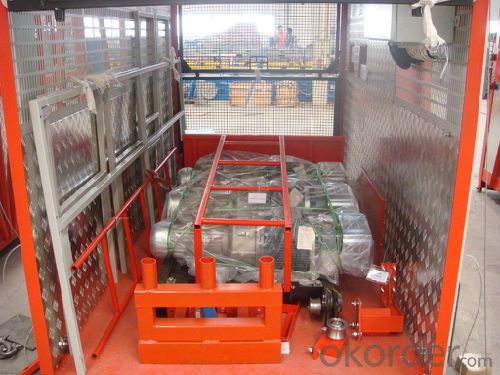
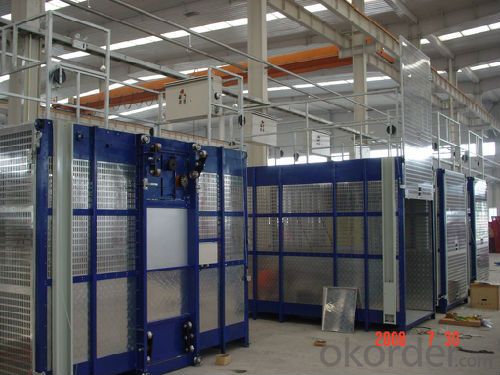
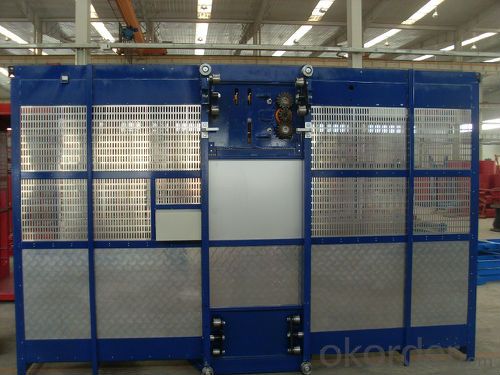
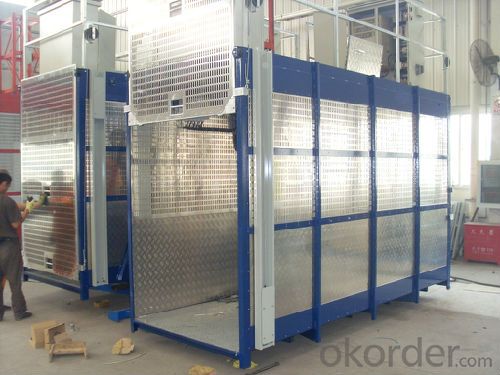
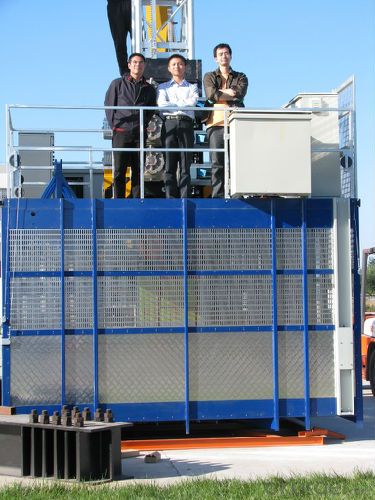
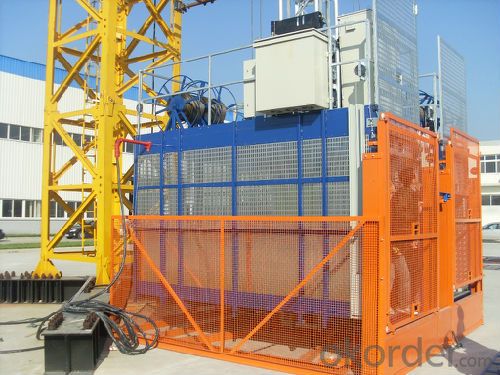
FAQ of Construction Hoist
Q: What is the building hoist main purpose?
A: Building hoist equipped with double or single cabin to transport the materials and labors up and down. It's the ideal
construction equipment for vertical transportation in the field of construction.
Q: What is the main structure of building hoist?
A: The P/M construction hoist mainly contains metal structure, driving system, electrical control system, cable guide & protection system, electrical top crane and safety device.
Q: What is the meaning of the building hoist’s code?
A: Take SC200/200 for example: “SC” stands for rack and pinion hoist, “200/200” stands for double cage and capacity is 2 tons per cage. “SC200” stands for single cage and capacity is 2 tons.
Q: What is the dimension of the cage?
A: Normally the cage dimension is 3X1.5X2.5M (L/W/H) for 2t type hoist. Details should be checked according to our quotation sheet. Also, the size can be customized according to the factual site condition. There are two doors (entrance& exit doors) for each cage, It can be produced as up & down sliding or ramping model for safety and convenience.
- Q: Is it safe to use a building hoist for lifting heavy objects when there is wind?
- <p>Using a building hoist in windy weather is generally not recommended due to the increased risk of accidents. Wind can cause the hoist to sway, potentially leading to loss of control and dropping of the load. Safety guidelines typically advise against hoisting operations when wind speeds exceed certain limits, often around 20-30 miles per hour (32-48 kilometers per hour). It's crucial to check local regulations and the manufacturer's guidelines for the specific hoist model to determine safe operating conditions. Always prioritize safety and ensure that all necessary precautions are taken to secure the load and the hoist in windy conditions.</p>
- Q: This question asks for the steps or procedures to keep a building hoist in good working condition.
- <p>Maintaining a building hoist involves regular inspections, lubrication, and repairs. Ensure all safety features are operational and that the hoist is clean and free of debris. Check cables for wear and replace them if necessary. Lubricate moving parts as per the manufacturer's recommendations. Inspect the electrical system for any signs of damage or wear. Regularly test the hoist's load capacity and emergency stop functions. Keep a maintenance log to track all inspections and repairs. If any issues are identified, address them promptly to prevent accidents and ensure the hoist operates safely and efficiently.</p>
- Q: The construction elevator always jumps
- The starting current is more than three times the running current, and your air switch is low in the maximum current
- Q: This question asks about the measures taken to guarantee the safety and reliability of lifting equipment prior to its use in construction.
- <p>To ensure that lifting equipment is safe and reliable before using it in construction work, several key steps must be taken. Firstly, regular inspections and maintenance are crucial to identify any potential issues or wear and tear. Secondly, all equipment should be thoroughly tested and certified by qualified personnel to meet safety standards. Thirdly, proper training for operators is essential to ensure they understand how to use the equipment safely. Additionally, having a comprehensive safety plan in place, including emergency procedures, can help prevent accidents. Lastly, using equipment from reputable manufacturers and ensuring all components are in good working order are also vital for maintaining safety and reliability.</p>
- Q: This question asks for guidance on selecting an appropriate building hoist for construction purposes.
- <p>To choose a suitable building hoist, consider the following: 1) Capacity: Ensure the hoist can handle the weight of materials to be lifted. 2) Construction site conditions: Choose a hoist that fits the site's dimensions and layout. 3) Safety features: Opt for a hoist with safety mechanisms like overload protection and emergency stop. 4) Maintenance: Select a hoist that requires minimal maintenance to reduce downtime. 5) Cost: Compare prices and consider the total cost of ownership, including maintenance and operation. 6) Manufacturer reputation: Choose a reputable manufacturer for quality and after-sales support. 7) Compliance: Ensure the hoist meets local safety regulations and standards. Always consult with a hoist expert or the manufacturer for specific advice tailored to your project's needs.</p>
- Q: Is the construction elevator a special equipment
- The construction elevator is special equipment, the installation and demolition of the special construction plan, after the installation, the special equipment can be tested and qualified for use
- Q: Is it possible to use a building hoist for the transportation of goods or materials?
- <p>Yes, building hoists are commonly used to transport goods and materials in construction projects. They are designed to lift and lower heavy materials such as bricks, cement, and tools, making the construction process more efficient and reducing the need for manual labor. Building hoists are equipped with safety features to ensure the secure transportation of materials, and they are an essential tool in many construction sites.</p>
- Q: Is it possible to replace a building hoist with an electric winch for the purpose of lifting materials or individuals?
- <p>While theoretically possible, using an electric winch instead of a building hoist for lifting materials or people is not recommended due to safety concerns and differences in design. Electric winches are typically designed for pulling or towing loads and may not have the necessary safety features, load capacity, or stability required for lifting operations in a construction setting. Building hoists are specifically engineered to lift heavy materials and personnel safely in vertical shafts or on the facade of a building. They are equipped with safety devices and are regulated for construction use, making them the appropriate choice for such tasks.</p>
- Q: This question asks about the method to determine the maximum weight a building hoist can safely support.
- <p>Calculating the maximum load capacity of a building hoist involves several factors. First, consider the hoist's mechanical design and the manufacturer's specifications, which provide the rated load capacity. This is the maximum weight the hoist is designed to handle. Next, assess the condition of the hoist, as wear and tear can reduce its capacity. Additionally, consider the strength of the supporting structure and the safety factor, which is typically a multiplier of the rated load capacity to ensure safety. For example, if the hoist is rated for 1000 kg, a safety factor of 1.5 means the actual maximum load should not exceed 667 kg (1000 kg / 1.5). Always consult with engineers and follow local regulations and standards for precise calculations.</p>
- Q: This question asks for criteria to differentiate between electric and hydraulic building hoists for selection based on specific needs.
- <p>When choosing between electric and hydraulic building hoists, consider the following: 1) Power Source: Electric hoists require a reliable electricity supply while hydraulic hoists need a power source for the hydraulic pump. 2) Lifting Capacity: Electric hoists often have higher lifting capacities. 3) Speed: Electric hoists generally offer faster lifting and lowering speeds. 4) Maintenance: Hydraulic hoists may require more frequent maintenance due to fluid changes and potential leaks. 5) Noise: Electric hoists are quieter. 6) Cost: Initial costs and operating expenses should be compared. 7) Safety: Both types have safety features, but electric hoists might offer more advanced safety options. 8) Environmental Factors: Consider weather conditions; electric hoists are less affected by rain and cold. Your choice should align with the project's specific requirements, such as the weight of materials to be lifted, frequency of use, and environmental conditions.</p>
Send your message to us
Building Hoist (Model:SC(D)270, SC(D)270/270)
- Loading Port:
- China main port
- Payment Terms:
- TT or LC
- Min Order Qty:
- 1 unit
- Supply Capability:
- 20 unit/month
OKorder Service Pledge
OKorder Financial Service
Similar products
Hot products
Hot Searches
Related keywords
